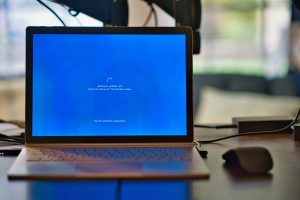
If your business is still running on Windows 10, the clock is ticking.
Microsoft is officially ending support for Windows 10 on 14th October 2025. After this date, Windows 10 will no longer receive security updates, bug fixes, or technical support. For any organisation that wants to stay secure, compliant, and competitive, it’s time to move to Windows 11.
Let’s break down what the Windows 10 end date means, the risks of not updating, and how to upgrade without disrupting your business.
What does the Windows 10 end date actually mean?
Every Microsoft product has a lifecycle. Windows 10 has had a good run since its launch in 2015, but all things tech must come to an end. As of 14th October 2025, Microsoft will stop:
- Issuing security updates and patches
- Providing technical support
- Offering bug fixes for any system vulnerabilities
If you’re still using Windows 10 beyond this point, your systems are on borrowed time and increasingly vulnerable.
Why this matters: Security, compliance, and Cyber Essentials
Without updates, Windows 10 becomes a weak point in your IT infrastructure. Unpatched systems are prime targets for cyber criminals, and the cost of a breach is higher than ever, both financially and reputationally.
Even more pressing: organisations adhering to Cyber Essentials (a UK Government-backed cybersecurity certification) must run supported software. Once Windows 10 reaches its end of life, any device still using it will fall out of compliance.
That means:
- You could fail a Cyber Essentials assessment
- Your cyber insurance might be invalidated
- You’ll be at greater risk of ransomware and malware attacks
What’s new in Windows 11?
If Windows 10 was about stability and familiarity, Windows 11 is about modernisation and productivity.
Here are some key benefits of making the move:
Stronger security by default
Windows 11 has hardware-based isolation, Secure Boot, and TPM 2.0 (Trusted Platform Module) requirements built-in. These features reduce the risk of sophisticated attacks like ransomware.
Optimised for hybrid work
With virtual desktops, Snap layouts, and improved multi-monitor support, Windows 11 is built for flexibility, whether you’re in the office, at home, or somewhere in between.
Improved performance and user experience
Faster boot times, better battery life on laptops, and a clean new interface make Windows 11 not just more secure, but actually more enjoyable to use.
The risks of not updating after 14th October
Still thinking of sticking with Windows 10 for a while longer? Here’s why that’s a risky move:
Increased cyber security threats
Hackers actively target outdated systems. Once Microsoft stops patching vulnerabilities, every new exploit becomes a potential disaster.
Loss of compliance
For industries that rely on Cyber Essentials or similar accreditations, unsupported software is a major red flag.
Decreased productivity
As software developers shift focus to Windows 11, your systems may gradually become incompatible with the latest tools and applications.
Higher long-term costs
Delaying the upgrade could mean rushed decisions later. And emergency upgrades always cost more, both in money and disruption.
How to prepare: Your Windows 11 update checklist
We’ve supported businesses across the South West through countless technology transitions. Here’s our recommended roadmap for a smooth upgrade:
- Audit your current systems
Identify which devices are still running Windows 10 and whether they meet the hardware requirements for Windows 11. - Review software compatibility
Make sure your critical apps and systems work seamlessly with Windows 11. - Create an upgrade plan
Stagger the rollout to minimise disruption, and ensure staff training is built in. - Backup everything
Always ensure your data is safely backed up before upgrading operating systems. - Work with an expert
If you’re not sure where to start, get support from a trusted IT partner (that’s us!).
Can’t upgrade yet? Here’s what you can do
Not all businesses can upgrade overnight. If you’re in that boat, here’s how you can buy some time:
- Upgrade where you can: Prioritise your most business-critical systems.
- Segment outdated devices: Isolate any Windows 10 machines from your core network.
- Use extended support: Microsoft offers paid extended support, and only a temporary solution.
But remember, these are just stopgaps, not strategies.
Why work with Timewade?
Upgrading your operating system isn’t just about ticking a compliance box. It’s about protecting your people, your data, and your reputation.
We take the stress out of system updates. Our team doesn’t just make sure your tech is compliant, we align it with your business goals. That means:
- No disruption to daily operations
- End-to-end project management
- Ongoing support and monitoring
- A future-ready IT environment
And with over four decades of experience supporting organisations across sectors like manufacturing, professional services, and education, we know what works.
Don’t wait until it’s too late
The Windows 10 end date on 14th October 2025 is a fundamental shift in your digital infrastructure. Businesses that act now will be more secure, compliant, and ready for whatever’s next. Those that don’t risk being left behind.
Ready to make the switch?
Contact Timewade to ensure your systems and software are always up to date, industry compliant, and secure.
Let’s future-proof your business together.




